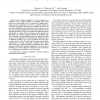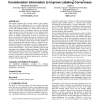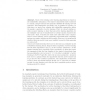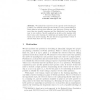113
click to vote
ICDM
2009
IEEE
15 years 7 months ago
2009
IEEE
—One common approach to active learning is to iteratively train a single classifier by choosing data points based on its uncertainty, but it is nontrivial to design uncertainty ...
113
click to vote
KDD
2009
ACM
15 years 7 months ago
2009
ACM
Data mining techniques have become central to many applications. Most of those applications rely on so called supervised learning algorithms, which learn from given examples in th...
127
click to vote
CCS
2009
ACM
15 years 7 months ago
2009
ACM
Anomaly detection for network intrusion detection is usually considered an unsupervised task. Prominent techniques, such as one-class support vector machines, learn a hypersphere ...
100
Voted
SAC
2009
ACM
15 years 7 months ago
2009
ACM
In active learning based music retrieval systems, providing multiple samples to the user for feedback is very necessary. In this paper, we present a new multi-samples selection st...
109
click to vote
CVPR
2010
IEEE
15 years 9 months ago
2010
IEEE
We present an active learning framework to simultaneously learn appearance and contextual models for scene understanding tasks (multi-class classification). Existing multi-class a...
105
Voted
ALT
2006
Springer
15 years 9 months ago
2006
Springer
Most of the existing active learning algorithms are based on the realizability assumption: The learner’s hypothesis class is assumed to contain a target function that perfectly c...
150
click to vote
ALT
2009
Springer
15 years 9 months ago
2009
Springer
Abstract. We analyze the expected cost of a greedy active learning algorithm. Our analysis extends previous work to a more general setting in which different queries have differe...
140
click to vote
FOIKS
2008
Springer
15 years 9 months ago
2008
Springer
Supervised learning deals with the inference of a distribution over an output or label space $\CY$ conditioned on points in an observation space $\CX$, given a training dataset $D$...
113
Voted
SDM
2009
SIAM
15 years 9 months ago
2009
SIAM
In active learning, one attempts to maximize classifier performance for a given number of labeled training points by allowing the active learning algorithm to choose which points...
112
click to vote
KDD
2007
ACM
16 years 28 days ago
2007
ACM
In many data mining applications, online labeling feedback is only available for examples which were predicted to belong to the positive class. Such applications include spam filt...





